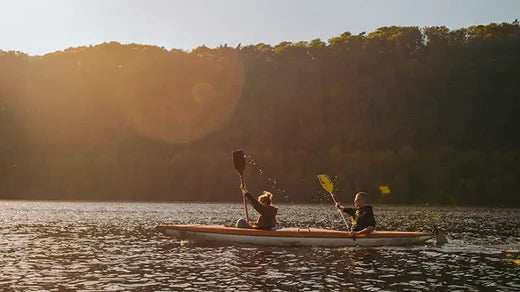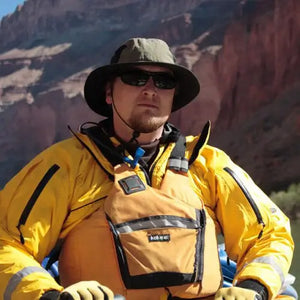What Is The Difference Between A Kayak And A Canoe?
May 06, 2022

What is the difference between a kayak and a canoe? While these two boats seem pretty similar, they have some striking differences you must be aware of. The ideal choice will depend on several factors. And today, we're going to unpack the kayak vs canoe debate to help you pick the right boat.
The kayak and canoe share many similarities - they require paddles and can even look similar depending on the specific boats. Please make no mistake, though. They are entirely different types of watercrafts. And the gear you'll use in paddling and transporting these boats also varies greatly.
While canoes typically feature an open top, kayaks have a closed deck. You'll sit with your legs stretched out in a kayak, whereas you'll sit on your knees in a canoe. Canoers use a single-bladed paddle, while kayakers use double-bladed paddles.
And that is just a few of the noteworthy differences you will learn about today. Let's not hold you in suspense any longer - it's time to break down the difference between a kayak and a canoe!
What's the Difference Between a Kayak and a Canoe?
The difference between a kayak and a canoe is that a kayak is a boat where you sit inside and use a paddle with blades on both ends. A canoe is open on top, and you either kneel or sit on a seat, using a paddle with one blade.
These are the basics; let's get into some more details.
What is a Kayak?
A kayak is a small watercraft propelled by a human using a double-bladed paddle. It was invented by the Inuit tribes in Alaska, Canada, and Greenland to help them hunt. The first models were made from wood and seal skin and built with a covered deck. The paddlers sat facing forward, legs in front and used the paddle to move through the water. Though the fundamental principles of kayaking have mostly stayed the same, the designs of modern kayaks are far different.
A kayak is typically smaller than a canoe and designed with a closed deck style. These are known as sit-on-top kayaks - and the premier choice on the market today. But there are all sorts of other types of kayaks. You'll find inflatable kayaks that can be blown up - these are a more "sit-in" style of boat. There are also fishing kayaks that resemble something more of a raft. Finally, there are hardshell kayaks that are built for performance paddling.
Whatever style you choose, you'll typically find a seat molded to the bottom to brace up against. This is very different from what you'll find in the cockpit of a canoe. You'll also find that you are seated far lower in the water in a kayak than in a canoe.
Whatever the kayak style, one thing remains consistent - how you sit on the boat. Kayakers sit on their butts with their legs out in front of them. And in terms of kayak paddles, double-bladed paddles are the norm. You can learn more about choosing a kayak paddle in our blog. It would help if you also looked at our discussion of how to paddle a kayak.
One last note on kayaks: they're far more versatile than canoes. There are whitewater kayaks and performance kayaks for racing on lakes. You can even go sea kayaking & paddle kayaks over waterfalls! There are no limits to what you can do with a kayak.
What is a Canoe?
A canoe is a lightweight, narrow boat pointed at both ends and open on top. It is propelled by one or more seated or kneeling paddlers, each using a single-bladed paddle. Canoes are used for recreation, transportation, and sports, offering stability and capacity for carrying people and gear on water.
What makes canoes different from kayaks? Canoes can be dated back as far as 8200 BC in what is now known as the Netherlands. This is the oldest documented boat in history.
Ok, enough with the history lesson - let's discuss the details. As we've discussed already, canoes feature a more open top that canoe paddlers can kneel within. That's right - you don't typically sit on your butt in a canoe. However, you do have a nice, cushioned bench-style pad to kneel upon. Canoes generally feature at least 2 to 3 of these benches to make it easier to paddle tandem.
One other striking difference is in the type of paddle you use. The double-bladed paddle is the norm for kayaking, whereas a single-bladed paddle is more typical for canoeing. It would help if you switched between paddling on the left and right sides to push your boat forward. As such, generating speed and maneuvering in a canoe is more complicated than in a kayak.
Because the canoe has higher sides, the paddler is more protected from wind and water splashing. However, not all canoes are created equal. There are inflatable canoes, racing canoes, whitewater canoes, and even recreational canoes. These are typically less versatile boats than kayaks because of their length, open top, and higher center of gravity.
Canoe vs. Kayak: Which Is Right For You?
We've talked enough about the differences between a kayak and a canoe. You came here to learn which of these is right for you. And to help you make that decision, we're going to quickly weigh the pros and cons of each to help you decide. Let's start with the pros and cons of kayaking.
Kayak Pros & Cons
Pros:
- Easier to learn the basics of kayaking than canoeing
- More versatile in different types of water
- You can paddle these faster and maneuver them better
- Transporting a kayak is much easier than a canoe
- You stay drier in a kayak with a spray skirt
- Paddling strokes are more efficient with a double-bladed paddle vs single blade paddle
Cons:
- The more advanced kayaking techniques take a while to master
- Kayaking is more exhausting for your body
- Learning in calm water only sometimes translates to learning in whitewater or the sea.
- Beginners tend to be scared of spray skirts.
Canoe Pros & Cons
Pros:
- Canoes are more extensive, making it easier to accommodate friends and additional gear
- They are more comfortable for long excursions
- Canoes are more stable boats with less risk of capsizing
- You'll have an easier time getting in and out of a canoe than a kayak
- Standing up on a canoe is easier and more fun
- If you need to portage, canoes are up to the task - kayaks are more challenging to portage with
- While you may start kneeling, you can alternate your seating position to keep your body comfortable and pain-free
Cons:
- Because canoes are more extensive and heavier, they are less easily transported to and from the water.
- If you're paddling solo, you'll tire quickly and need help generating speed.
- It's also challenging to learn how to paddle a canoe solo
- Canoes take on a bit more water than kayaks, so expect to get wet
What's The Difference Between Kayaking & Canoeing?
So, which of these boats should you go with? The answer is not one size fits all. Your personal preferences will help you make the right decision. And if you're still deciding, you don't have to choose right now. You can try each out a few times by renting them at a lake or pond near you! This is the best way to determine which boat best suits you. They're both great options, and you can't go wrong either way - because you'll be out-connected with nature.
For all your canoe and kayak accessories, shop at OutdoorPlay. We have everything you need for your next adventure on the water—from spray skirts to paddles, lifejackets, transportation essentials, and much more!

